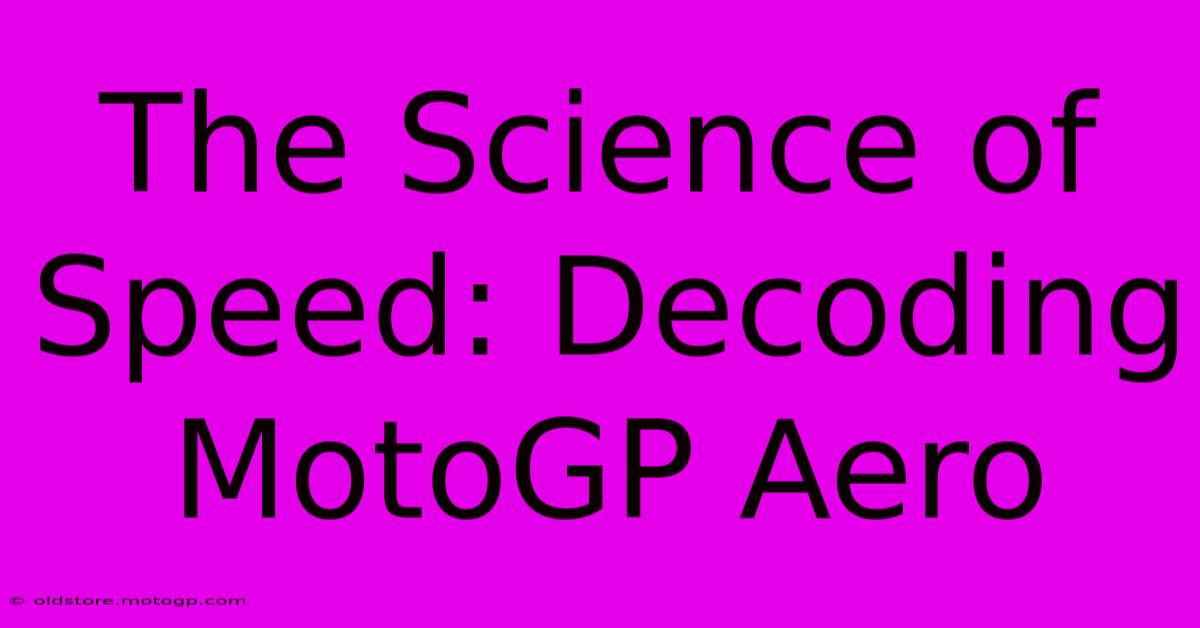The Science Of Speed: Decoding MotoGP Aero

Table of Contents
The Science of Speed: Decoding MotoGP Aero
MotoGP. The pinnacle of motorcycle racing. The sheer speed, the breathtaking overtaking maneuvers, the nail-biting finishes – it all captivates millions. But beneath the surface of the adrenaline-fueled spectacle lies a complex interplay of engineering prowess, rider skill, and cutting-edge technology. One crucial element often overlooked is aerodynamics, or MotoGP aero, the science of manipulating airflow to gain a competitive edge. This article delves into the fascinating world of MotoGP aero, exploring its impact on performance and the constant evolution driven by relentless innovation.
Understanding the Importance of Aerodynamics in MotoGP
In the high-stakes world of MotoGP, even the smallest advantage can mean the difference between victory and defeat. At speeds exceeding 200 mph (320 km/h), aerodynamic forces become incredibly significant. MotoGP aero isn't just about looking sleek; it's about generating downforce, reducing drag, and enhancing stability at extreme velocities. These factors directly influence:
- Cornering Speed: Downforce, generated by aerodynamic devices, presses the motorcycle and rider firmly onto the track, allowing for higher cornering speeds without losing traction. This is crucial for maintaining momentum and gaining time on rivals.
- Braking Performance: Increased downforce improves braking stability, enabling riders to brake later and harder into corners, further enhancing lap times.
- Straight-Line Speed: Minimizing drag is essential for achieving top speed on straights. Streamlined bodywork and carefully designed aerodynamic elements reduce air resistance, allowing the bike to accelerate faster and maintain higher velocities.
- Stability and Control: Aerodynamic devices help maintain stability at high speeds and during aggressive maneuvers, reducing the chances of high-side or low-side crashes. This improves rider confidence and allows for more consistent lap times.
The Key Components of MotoGP Aerodynamics
Modern MotoGP bikes are masterpieces of aerodynamic engineering, featuring a multitude of sophisticated components designed to optimize airflow:
- Fairings: The bodywork of the motorcycle, meticulously sculpted to minimize drag and channel airflow effectively. The design is constantly refined using Computational Fluid Dynamics (CFD) simulations.
- Wings: These prominent aerodynamic appendages generate downforce, improving stability and cornering speed. Their design, size, and angle are crucial for balancing downforce and drag. The placement and angle of these wings are constantly adjusted based on the track and conditions.
- Winglets: Smaller aerodynamic elements often found on the front fairing and other parts of the bike. These contribute to overall downforce and airflow management.
- Underbody Aerodynamics: The design of the underbody is critical for generating ground effect, which increases downforce without significantly increasing drag. This is a complex area of aerodynamic design requiring sophisticated simulation and testing.
The Constant Evolution of MotoGP Aero
The development of MotoGP aero is a never-ending process. Teams constantly strive for incremental improvements, using advanced simulations and wind tunnel testing to refine designs. New regulations and technological advancements further drive this evolution. We've seen a dramatic increase in the complexity and sophistication of aerodynamic devices over recent years, reflecting the intense competition and the relentless pursuit of performance gains.
The Role of Technology and Innovation
The development of MotoGP aero relies heavily on cutting-edge technology:
- Computational Fluid Dynamics (CFD): CFD simulations allow engineers to virtually test different aerodynamic designs, optimizing airflow and minimizing drag before physical prototypes are even built. This saves significant time and resources.
- Wind Tunnel Testing: Physical wind tunnel testing allows engineers to validate CFD simulations and fine-tune designs based on real-world data. This provides crucial insights into the performance of various aerodynamic components.
- Data Acquisition and Analysis: Sophisticated data acquisition systems on the bikes collect vast amounts of data during testing and races. This data is then analyzed to further optimize aerodynamic performance.
Conclusion: The Future of MotoGP Aero
The science of speed in MotoGP is constantly evolving, and aerodynamics plays a pivotal role. The ongoing development and refinement of aerodynamic devices will undoubtedly continue to shape the future of the sport. As technology advances, we can expect even more sophisticated and effective aerodynamic solutions to emerge, pushing the boundaries of speed and performance in this thrilling motorsport. The constant battle between drag reduction and downforce generation will always be a central theme in the quest for ultimate speed and control. The evolution of MotoGP aero is a testament to human ingenuity and the relentless pursuit of excellence.

Thank you for visiting our website wich cover about The Science Of Speed: Decoding MotoGP Aero. We hope the information provided has been useful to you. Feel free to contact us if you have any questions or need further assistance. See you next time and dont miss to bookmark.
Featured Posts
-
F1 Austin Explore The City Beyond The Track
Feb 25, 2025
-
The Science Behind Moto2 Motorcycles
Feb 25, 2025
-
Cota One Day Pass Your Columbus Adventure Starts Now
Feb 25, 2025
-
Cota Parking Lot T Your Parking Questions Answered
Feb 25, 2025
-
Witness The Culmination Of A Season Moto Gp On Nbc
Feb 25, 2025
